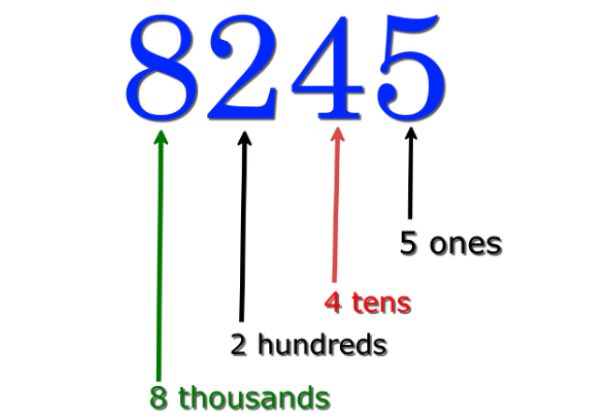Place value is a mathematics term that refers to the positional value of digits within a number. See below to learn more about place value system.
However, to write million in the number system, enter the numbers and click on the “Show” button. On clicking, you will get the numbers in both Indian and international number systems.
| Country | Numeric Value | |
|---|---|---|
| Indian | ||
| International |
| Number | Indian | International |
|---|
What is Place Value?
Place Value in mathematics refers to the positional importance of digits within a number. The value of each digit in a number varies depending on its position.
In the decimal system, moving to the left increases the value of a digit ten times, while moving to the right decreases ten times.
For example, in 8245, the ‘8’ digit represents the 8000 (8 × 1000), the ‘2’ digit represents the 200 (2 × 100), and the ‘4’ digit represents 40 (4 × 10) and the ‘5’ digit represents 5 (5 × 1).
Thus it is expressed as one, ten, hundred, thousand, lakh, million, crore, billion, etc.
Place Value of a Number (8245):

In the Indian system, it is eight thousand, two hundred and forty-five.
- 1000 × 8 = 8000 (8 thousand)
- 200 × 2 = 200 ( 2 hundred)
- 10 × 4 = 40 (forty)
- 1 × 5 = 5 (five)
In words “eight thousand two hundred and forty five”.
Place Value System Chart
There are two types of place value charts, Indian and International place value. The Indian place value chart is based on the Indian numerical system, while the International is based on the internationally accepted numerical system.
However, this helps us know that the numbers are aligned in the right places. The chart also shows the exact position of a digit in a number.
Indian Place Value System Chart:
| Periods | Figures | Digit |
|---|---|---|
| Crores | Ten Crore 10,00,00,000 | 9 |
| Crore 1,00,00,000 | 8 | |
| Lakhs | Ten Lakh 10,000,00 | 7 |
| Lakh 1,00,000 | 6 | |
| Thousands | Ten Thousand 10,000 | 5 |
| Thousand 1,000 | 4 | |
| Ones | Hundred 100 | 3 |
| Ten 10 | 2 | |
| One 1 | 1 |
International Place Value System Chart:
Below is the international place value chart that is widely used in the world:
| Periods | Figures | Digit |
|---|---|---|
| Millions | Hundred Million 100,000,000 | 9 |
| Ten Million 10,000,000 | 8 | |
| Million 1,000,000 | 7 | |
| Thousands | Hundred Thousand 100,000 | 6 |
| Ten Thousand 10,000 | 5 | |
| Thousand 1,000 | 4 | |
| Ones | Hundred 100 | 3 |
| Ten 10 | 2 | |
| One 1 | 1 |
How to write millions in numbers?
In the numerical system, “million” is represented as 1,000,000. Here is how to represent the number of millions when you write it:
The number one million is 1,000,000:
- The number ‘1’ at the beginning represents one million.
- These are followed by six zeros (0), which represent a specific value of the digits in each place.
- When we move from right to left, the value of each zero increases by ten times. So, the first zero represents 10, the second represents 100, the third represents 1,000, and thus the sixth represents 1,000,000.
So, the number 1,000,000 is a numerical value of one million in the international numeral system and 10 lakh in the Indian numeral system. It is a numerical term in mathematics where large numbers are measured. Please see here to convert lakhs to millions or other number systems.
FAQs
A million is a numerical value that equals one thousand thousand (1000 × 1000 = 1,000,000) 1,000,000 or any other way. It is used to describe large amounts or numbers, such as one million dollars or one million people.
There are six zeros in one million. When it is written in a numerical system, it is written as 1,000,000.
In the context of mathematics, the concept of a million refers to knowing large numbers or understanding quantities.
A billion is a numerical value that equals one thousand million or 1,000,000,000. It is used to denote a very large number, or quantity, or is related to finance, population, or measurement.
